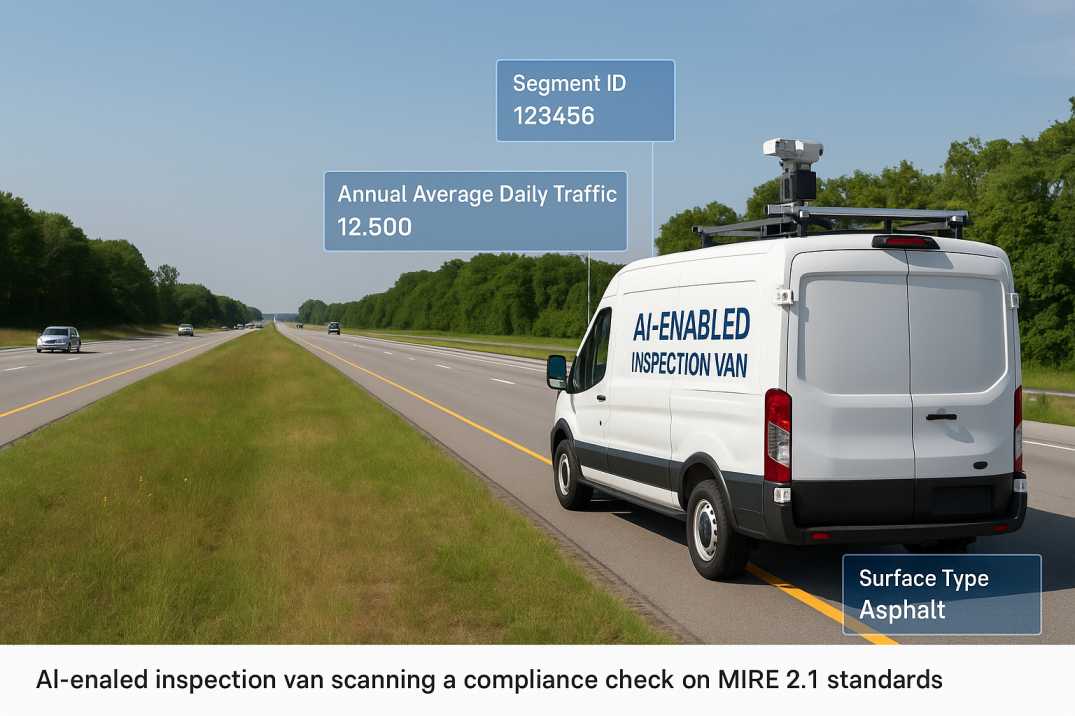Contact Us
RoadVision AI
Private Limited
Office No. 308 & 310, B Block
Ansal Chamber - 1, Bhikaji Cama Place,
Near Engineers India Limited (EIL) Bhawan, New Delhi - 110066
© 2024 | RoadVision AI | All rights reserved
In the era of AI-powered road inventory and automated roadway element detection, having standardized, high-quality roadway data is no longer optional—it’s essential. In the United States, the Federal Highway Administration (FHWA) developed the Model Inventory of Roadway Elements (MIRE) 2.1 as a robust framework to help agencies systematically collect, manage, and analyze roadway and traffic data.
This guide explores how MIRE 2.1 aligns with cutting-edge AI roadway inspection systems, supports predictive analysis, and integrates seamlessly with modern AI road asset management tools like those developed by RoadVision AI.

MIRE 2.1 is the latest version of a comprehensive data model created by the FHWA to guide state and local agencies in collecting uniform, geospatially accurate roadway and traffic data. It expands on earlier versions (MMIRE, MIRE 1.0, and MIRE 2.0), introducing a refined list of 202 data elements to be collected across all public roads.
Its core mission? To enable data-driven safety analysis, better decision-making, and compliance with federal regulations—especially for the Highway Safety Improvement Program (HSIP).
Under federal mandates, States must collect 37 Fundamental Data Elements (FDEs) on all public roads by September 30, 2026. These include essential information such as:
This standardized framework ensures that agencies can efficiently implement predictive safety analysis, fulfill HSIP goals, and integrate with platforms like RoadVision AI’s pavement condition surveys.
With the growing adoption of AI road inspection technologies, MIRE 2.1 provides the foundational data structure that supports automated roadway element detection. By aligning MIRE data with AI-driven tools, transportation agencies can:
RoadVision AI has pioneered such integrations, using machine vision, deep learning, and geospatial tagging to extract MIRE-compatible data directly from roads during active inspection.
One of MIRE 2.1’s key advancements is its alignment with the Highway Safety Manual (HSM) and Safe System Approach. This means the data it mandates supports:
When paired with AI road asset management platforms like RoadVision AI, these datasets enable dynamic, proactive infrastructure planning rather than reactive maintenance.
Traditional methods of collecting MIRE data (manual surveys, static GPS data) are slow and resource-intensive. Enter AI-powered road inventory solutions.
Using technologies like LiDAR, 360° imaging, and deep learning, tools like those provided by RoadVision AI’s road inventory inspection service automate the extraction of:
These insights are generated from video or imagery captured via dashcams or inspection vans, drastically reducing the time and cost of compliance.
To meet the federal deadline, agencies must:
RoadVision AI offers a complete suite of solutions aligned with MIRE 2.1 standards. Through AI-driven road safety audits, automated pavement assessments, and dynamic traffic surveys, the platform helps municipalities and DOTs:
Explore our services:
Accurate MIRE data leads to:
As AI continues to transform how roads are monitored and maintained, MIRE 2.1 and tools like RoadVision AI provide the structure and scalability to build a future-ready transportation network.
MIRE 2.1 isn’t just a federal requirement. It’s a blueprint for the future of roadway data management in the USA, enabling AI roadway inspection systems, predictive safety analysis, and automated infrastructure planning.
RoadVision AI is revolutionizing the way we build and maintain infrastructure by leveraging the power of AI in roads to enhance road safety and optimize road management. By utilizing cutting-edge roads AI technology, the platform enables the early detection of potholes, cracks, and other road surface issues, ensuring timely maintenance and improved road conditions.
With a mission to build smarter, safer, and more sustainable roads, RoadVision AI ensures full compliance with IRC Codes as well as MIRE 2.1 standards, empowering engineers and infrastructure stakeholders to make data-driven decisions that cut costs, reduce risks, and enhance the overall transportation experience.
Book a demo with RoadVision AI to see how your agency can automate compliance and lead the way in intelligent road infrastructure.
Q1. What is the deadline for MIRE 2.1 compliance?
All U.S. States must have access to MIRE Fundamental Data Elements on public roads by September 30, 2026, per FHWA regulations.
Q2. How can AI help with MIRE 2.1 compliance?
AI enables automated data collection, reduces errors, enhances coverage, and aligns collected data directly with MIRE specifications.
Q3. What data is included in MIRE FDEs?
MIRE FDEs include 37 essential elements such as road type, traffic volume, intersections, surface type, and ramp features.